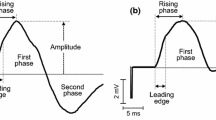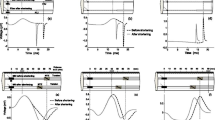Abstract
Attention of the investigators is usually pointed to the peak-to-peak characteristics of single-fiber action potentials (SFAPs) that are mainly determined by the depolarizing phase of the intracellular action potential (IAP). However, the final portion of the SFAP has often specific shape that has to be related to peculiarities of the repolarization phase of IAP and the duration of its spike. A novel piecewise SFAP model is proposed to achieve greater insight into the nature of declining portion of the negative phase and of the third phase of SFAP. It was found that the SFAP third phase is essentially determined by the specific profile of the transition of the IAP falling phase toward the resting voltage, whereas the SFAP declining negative phase is more dependent upon the width of the corresponding IAP spike. We tentatively suggest that the duration of the spike of human IAPs should be over approximately 0.75 ms.








Similar content being viewed by others
References
Akaike N (1978) Resting and action potentials in white muscle of potassium deficient rats. Comp Biochem Physiol A Physiol 61:629–633
Albers BA, Put JH, Wallinga W, Wirtz P (1989) Quantitative analysis of single muscle fiber action potentials recorded at known distances. Electroencephalogr Clin Neurophysiol 73(3):245–253
Albuquerque EX, Thesleff S (1968) A comparative study of membrane properties of innervated and chronically denervated fast and slow skeletal muscles of the rat. Acta Physiol Scand 73:471–480
Andreassen S, Rosenfalck A (1981) Relationship of intracellular and extracellular action potentials of skeletal muscle fibers. CRC Crit Rev Bioeng 7:267–306
Arabadzhiev T, Dimitrov GV, Chakarov V, Dimitrov A, Dimitrova NA (2008) Effects of changes in intracellular action potential on potentials recorded by single-fiber, macro, and belly-tendon electrodes. Muscle Nerve 37:700–712
Dimitrov GV, Dimitrova NA (1979) Influence of the afterpotentials on the shape and magnitude of the extracellular potentials generated under activation of excitable fibres. Electromyogr Clin Neurophysiol 19:249–267
Dimitrov GV, Dimitrova NA (1998) Precise and fast calculation of the motor unit potentials detected by a point and rectangular plate electrode. Med Eng Phys 20:374–381
Dimitrova NA (1973) Influence of the length of the depolarized zone on the extracellular potential field of a single unmyelinated nerve fiber. Electromyogr Clin Neurophysiol 13:547–558
Dimitrova NA, Dimitrov GV (2006) Electromyography (EMG) modeling. In: Metin A (ed) Wiley encyclopedia of biomedical engineering. Wiley, Hoboken
Duchene J, Hogrel JH (2000) A model of EMG generation. IEEE Trans Biomed Eng 47:192–201
Dumitru D (1994) The biphasic morphology of voluntary and spontaneous SFAPs. Muscle Nerve 17:1301–1307
Ekstedt J (1964) Human single fibre action potentials. Acta Physiol Scand 61(226):1–96
Farina D, Merletti R (2001) A novel approach for precise simulation of the EMG signal detected by surface electrodes. IEEE Trans Biomed Eng 48(6):637–646
Fleisher SM (1984) Comparative analysis of modelled extracellular potentials. Med Biol Eng Comput 22:440–447
Fortune E, Lowery MM (2011) Simulation of the interaction between muscle fiber conduction velocity and instantaneous firing rate. Ann Biomed Eng 39(1):96–109
Griep PAM, Boon KL, Stegeman DF (1978) A study of the motor unit action potential by means of computer simulation. Biol Cybern 30:221–230
Gootzen TH, Stegeman DF, Van Oosterom A (1991) Finite limb dimensions and finite muscle length in a model for the generation of electromyographic signals. Electroencephalogr Clin Neurophysiol 81(2):152–162
Gydikov A (1991) Biophysics of the skeletal muscle extracellular potentials. Bulg Acad Sci 132:60–100
Hanson J (1974) Effects of repetitive stimulation on membrane potentials and twitch in human and rat intercostal muscle fibers. Acta Physiol Scand 92:238–248
Henriquez CS, Plonsey R (1988) The effect of the extracellular potential on propagation in excitable tissue. Comments Theor Biol 1:47–64
Ludin HP (1969) Microelectrode study of normal human skeletal muscle. Eur Neurol 2(6):340–347
Ludin HP (1970) Microelectrode study of dystrophic human skeletal muscle. Eur Neurol 3(2):116–121
Ludin HP (1973) Action potentials of normal and dystrophic human muscle fibers. In: Desmedt JE (ed) New development in electromyography and clinical neurophysiology. Karger, Basel, pp 400–406
McGill KC, Lateva ZC (2001) A model of the muscle-fiber intracellular action potential waveform, including the slow repolarization phase. IEEE Trans Biomed Eng 48:1480–1483
Miller-Larson A (1985) An analysis of extracellular single muscle fiber. Biol Cybern 51:271–284
Nandedkar S, Stålberg E (1983) Simulation of single muscle fiber action potentials. Med Biol Eng Comput 21:158–165
Nandedkar S, Sanders DB (1988) Simulation of concentric needle EMG motor unit action potentials. Muscle Nerve 11:151–159
Piotrkiewicz M, Miller-Larsson A (1987) A method of description of single muscle fiber activity. Biol Cybern 56:237–245
Plonsey R (1974) The active fiber in a volume conductor. IEEE Trans Biomed Eng 21:371–381
Radicheva N, Gerilovsky L, Gydikov A (1986) Changes in the muscle fiber extracellular action potentials in long-lasting (fatiguing) activity. Eur J Appl Physiol Occup Physiol 55(5):545–552
Rodriguez-Falces J, Malanda-Trigueros A, Gila-Useros L, Rodriguez -Carreño I, Navallas-Irujo J (2006) Modelling fibrillation potentials—a new analytical description for the muscle intracellular action potential. IEEE Trans Biomed Eng 53:581–592
Rodríguez J, Malanda A, Gila L, Rodriguez I, Navallas J (2011) Estimating the duration of intracellular action potentials in muscle fibres from single-fibre extracellular potentials. J Neurosci Meth 197(221):230
Rodriguez J, Malanda A, Gila L, Rodriguez I, Navallas J (2011) The peak-to-peak ratio of single-fibre potentials is little influenced by changes in the electrode positions close to the muscle fibre. J Electromyogr Kinesiol 21:423–432
Rosenfalck P (1969) Intra- and extracellular fields of active nerve and muscle fibers. A physico-mathematical analysis of different models. Acta Physiol Scand 321:1–168
Stålberg E (1966) Propagation velocity in human muscle fibers in situ. Acta Physiol Scand 287:1–112
Stålberg E, Trontelj J (1979) Single fiber electromyography. Raven Press, Old Woking
Trayanova NA, Dimitrov GV (1982) Extracellular potentials in the proximity of the excitable fibers. Electromyogr Clin Neurophysiol 22:291–301
Van Veen BK, Wolters H, Wallinga W (1993) The bioelectrical source in computing single muscle fiber action potentials. Biophys J 64:1492–1498
Wallinga W, Gielen FLH, Wirtz P, de Jong P, Broenink J (1985) The different intracellular action potentials of fast and slow muscle fibers. Electromyogr Clin Neurophysiol 60:539–547
Author information
Authors and Affiliations
Corresponding author
Rights and permissions
About this article
Cite this article
Rodriguez-Falces, J., Navallas, J., Gila, L. et al. Influence of the shape of intracellular potentials on the morphology of single-fiber extracellular potentials in human muscle fibers. Med Biol Eng Comput 50, 447–460 (2012). https://doi.org/10.1007/s11517-012-0879-7
Received:
Accepted:
Published:
Issue Date:
DOI: https://doi.org/10.1007/s11517-012-0879-7




